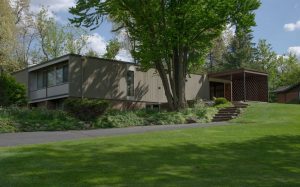Botch / Aaron Open House
 On the afternoon of January 13th the Aarons, who soon intend to sell the Metcalf home known as the Botch House, will be holding an open house for our a2modern friends. Tickets may be purchased here.
On the afternoon of January 13th the Aarons, who soon intend to sell the Metcalf home known as the Botch House, will be holding an open house for our a2modern friends. Tickets may be purchased here.
Architect Robert Metcalf’s 1958 presentation drawing lifted the Botch House on Chestnut Street just above the crest of the ridge. A rising walkway led to three steps up to the startling entrance portico, while a sweeping white retaining wall created an illusion of floating. It is an extraordinary drawing of an extraordinary house.
A visitor approaching from the street today would see a house gently nestled into the site, the entranceway firmly set on the ground, and rather than a retaining wall (which was not built) a berm landscaped so as to conceal the driveway area at the northwestern end of the house. It is a better solution altogether, and the landscaping and other work supervised by the present owner, an architect herself, won a Preservation Award from the Ann Arbor Historic District Commission in June 2017.
Vintage photos of the interior of the Botch House (see 1055 Chestnut/Old News) emphasized openness to light and the natural beauty of the setting. Sited along a northeast to southwest axis, the all-windows private side of the house facing a golf course receives indirect sunlight all day long. Attention to the sun also explains the elegant screen on the portico: it modulates the raking afternoon sunlight.
In its essence, a “modern” house must be designed specifically for the client. In this instance, Dr. Edmund Botch asked for a discreet area off the master bedroom where he could, when necessary, dress and quietly leave the house to see a patient or keep an appointment. The intricate living area that resulted, including the master bedroom and two large bedrooms, has to be experienced to be fully appreciated.
The present owners, Richard and Yuni Aaron, bought the house in 2006. A series of practical updatings took place in the following years, including replacing almost all of the windows, redesigning storage spaces in the kitchen to accommodate new appliances (without changing either dimensions or materials), replacing carpeted areas with light-toned hardwood flooring, and creating two bedrooms in the lower level area. On the other hand, the buff brown tile used on the portico floor, through the entranceway, and into dining area was left untouched.
When the new owners invited Robert Metcalf to Thanksgiving Dinner, he brought his little black book, in which he had noted, to the penny, the original cost of the house. Two of his trademark touches add romance to the simplicity of its modernist flat roof, continuous expanses of glass, warm tile floor, patio areas, and indirect lighting—an elegant wooden screen separates the dining area from the portico entrance; and on either side of the living room fireplace, niches of purple-rose stained glass complement the pink marble of hearth and over mantle.
It is a big, very proud house, now updated by an architect who thoroughly understands the legacy of a brilliant architect. Together, the Aarons have earned the right to the re-identification of this house as the Botch/Aaron House.
Written by: Jeffrey Welch
